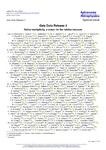Gaia Data Release 3: Stellar multiplicity, a teaser for the hidden treasure

Use este enlace para citar
http://hdl.handle.net/2183/37649
Excepto si se señala otra cosa, la licencia del ítem se describe como Creative Commons Attribution License
Colecciones
- Investigación (FIC) [1685]
Metadatos
Mostrar el registro completo del ítemTítulo
Gaia Data Release 3: Stellar multiplicity, a teaser for the hidden treasureAutor(es)
Fecha
2023Cita bibliográfica
Gaia Collaboration, Arenou, F., et al. (2023). Gaia Data Release 3: Stellar multiplicity, a teaser for the hidden treasure. Astronomy and Astrophysics, 674. https://doi.org/10.1051/0004-6361/202243782
Resumen
[Abstract] Context. The Gaia DR3 catalogue contains, for the first time, about 800 000 solutions with either orbital elements or trend parameters for astrometric, spectroscopic, and eclipsing binaries, and combinations of these three.
Aims. With this paper, we aim to illustrate the huge potential of this large non-single-star catalogue.
Methods. Using the orbital solutions and models of the binaries, we have built a catalogue of tens of thousands of stellar masses or lower limits thereof, some with consistent flux ratios. Properties concerning the completeness of the binary catalogues are discussed, statistical features of the orbital elements are explained, and a comparison with other catalogues is performed.
Results. Illustrative applications are proposed for binaries across the Hertzsprung-Russell Diagram (HRD). Binarity is studied in the giant branch and a search for genuine spectroscopic binaries among long-period variables is performed. The discovery of new EL CVn systems illustrates the potential of combining variability and binarity catalogues. Potential compact object companions are presented, mainly white dwarf companions or double degenerates, but one candidate neutron star is also found. Towards the bottom of the main sequence, the orbits of previously suspected binary ultracool dwarfs are determined and new candidate binaries are discovered. The long awaited contribution of Gaia to the analysis of the substellar regime shows the brown dwarf desert around solar-type stars using true rather than minimum masses, and provides new important constraints on the occurrence rates of substellar companions to M dwarfs. Several dozen new exoplanets are proposed, including two with validated orbital solutions and one super-Jupiter orbiting a white dwarf, all being candidates requiring confirmation. Besides binarity, higher order multiple systems are also found.
Conclusions. By increasing the number of known binary orbits by more than one order of magnitude, Gaia DR3 will provide a rich reservoir of dynamical masses and an important contribution to the analysis of stellar multiplicity.
Palabras clave
Binaries general
Astrometry
Planetary systems
Stars fundamental parameters
Catalogs
White dwarfs
Astrometry
Planetary systems
Stars fundamental parameters
Catalogs
White dwarfs
Versión del editor
Derechos
Creative Commons Attribution License






